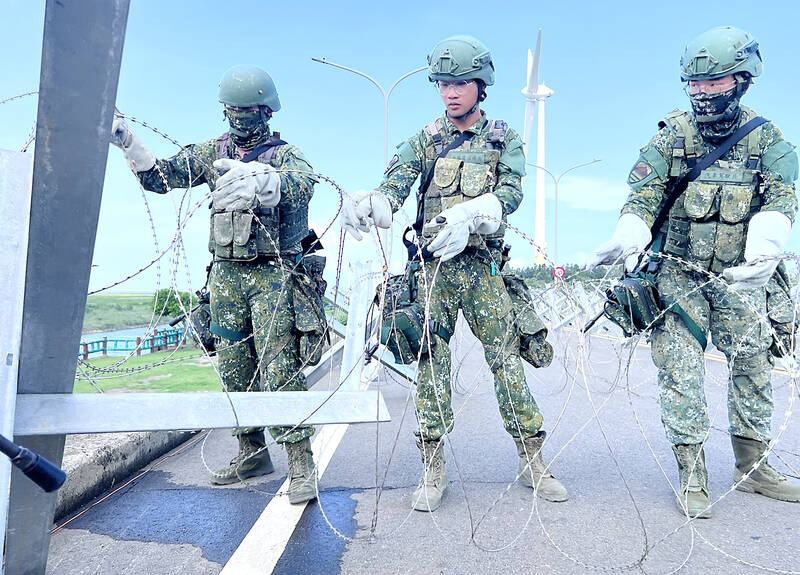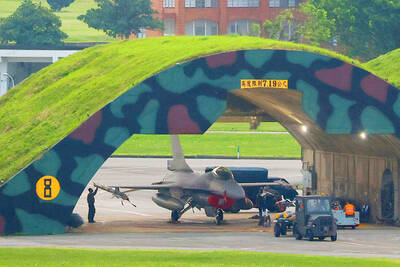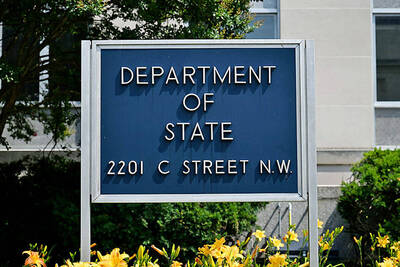The army’s 21st Artillery Command conducted a short-range air defense drill in Taoyuan yesterday as part of the Han Kuang exercises, using the indigenous Sky Sword II (陸射劍二) missile system for the first time in the exercises.
The armed forces have been conducting a series of live-fire and defense drills across multiple regions, simulating responses to a full-scale assault by Chinese forces, the Ministry of National Defense said.
The Sky Sword II missile system was rapidly deployed and combat-ready within 15 minutes to defend Taiwan Taoyuan International Airport in a simulated attack, the ministry said.

Photo: Lee Jung-ping, Taipei Times
A three-person crew completed setup and launch preparations, then remote control and radar targeting were used to engage simulated threats.
The Sky Sword II has a range of 2km to 15km and can be launched remotely or from a vehicle, enhancing flexibility and survivability in combat scenarios, it said.
The training was focused on joint anti-landing operations, aerial and missile defense, and counter-airborne assaults on key military and civilian infrastructure, it said.

Photo: Liao Yao-tung, Taipei Times
The exercises simulated a scenario in which Chinese warplanes crossed the Taiwan Strait’s median line during a combat patrol. It included remote-controlled firing procedures and radar targeting, which enhanced “survivability” during the drills, it said.
The portable Stinger air-defense missile purchased from the US was also revealed to the public for the first time in a separate drill in New Taipei City.
Separately, on the coast of Taichung’s Dajia District (大甲), the Fifth Theater Command executed a live anti-landing and road-denial exercise. Soldiers constructed layered coastal defenses to stop an enemy beach landing. Tank ditches, wave breakers and barbed obstacles were used.
A key feature of this year’s drill was the debut of the HESCO barrier system — a rapid-deployment blast wall used by US forces in Afghanistan and Iraq. With only two soldiers and an excavator, a 10m defensive wall was built in just 20 minutes, significantly faster than the sandbag method, it said.
In Penghu County, the First Theater Command staged a counter-airborne operation at the island’s airport, simulating an enemy attempt to sabotage critical infrastructure via helicopter assault.
“Troops quickly mobilized, linked up with airport security forces and neutralized the threat, demonstrating cross-service coordination and rapid response capabilities,” it said.
The drill reflected the shift in Penghu’s focus from traditional beach defense to integrated protection of key installations, aligning with more realistic modern combat scenarios, it added.
In Lienchiang County, the army’s amphibious unit conducted a sea surveillance drill after simulating a coastal radar failure.
Troops quickly outfitted a patrol boat with heavy machine guns and deployed it offshore to monitor maritime activity using sea-level radar, it said, adding that the operation aimed to “maintain domain awareness and reinforce maritime security in the absence of primary detection systems.”
Artillery units stationed in Kinmen County also held exercises, executing rapid-deployment drills, moving into tactical positions and establishing firepower readiness under improvised conditions, it said.
In southern Taiwan, Marine Corps units from the 99th Brigade initiated rapid redeployment northward late on Saturday evening using Humvees and medium tactical vehicles, it said.
“After resting at the 66th Brigade’s base in Taoyuan, the Marine Corps can join upcoming live-fire drills in northern Taiwan, reflecting the armed forces’ ability to shift reinforcements across regions in response to evolving threats,” it said.
The ministry said that all exercises were conducted under a “scenario-based, unscripted” format to better prepare personnel for real-time threats and unexpected battlefield developments.
Additional reporting by Aaron Tu and Huang Ching-hsuan

MISINFORMATION: The generated content tends to adopt China’s official stance, such as ‘Taiwan is currently governed by the Chinese central government,’ the NSB said Five China-developed artificial intelligence (AI) language models exhibit cybersecurity risks and content biases, an inspection conducted by the National Security Bureau (NSB) showed. The five AI tools are: DeepSeek, Doubao (豆包), Yiyan (文心一言), Tongyi (通義千問) and Yuanbao (騰訊元寶), the bureau said, advising people to remain vigilant to protect personal data privacy and corporate business secrets. The NSB said it, in accordance with the National Intelligence Services Act (國家情報工作法), has reviewed international cybersecurity reports and intelligence, and coordinated with the Ministry of Justice Investigation Bureau and the National Police Agency’s Criminal Investigation Bureau to conduct an inspection of China-made AI language

BOOST IN CONFIDENCE: The sale sends a clear message of support for Taiwan and dispels rumors that US President Donald Trump ‘sold out’ the nation, an expert said The US government on Thursday announced a possible sale to Taiwan of fighter jet parts, which was estimated to cost about US$330 million, in a move that an expert said “sends a clear message of support for Taiwan” amid fears that Washington might be wavering in its attitude toward Taipei. It was the first announcement of an arms sale to Taiwan since US President Donald Trump returned to the White House earlier this year. The proposed package includes non-standard components, spare and repair parts, consumables and accessories, as well repair and return support for the F-16, C-130 and Indigenous Defense Fighter aircraft,

CHECKING BOUNDARIES: China wants to disrupt solidarity among democracies and test their red lines, but it is instead pushing nations to become more united, an expert said The US Department of State on Friday expressed deep concern over a Chinese public security agency’s investigation into Legislator Puma Shen (沈伯洋) for “secession.” “China’s actions threaten free speech and erode norms that have underpinned the cross-strait ‘status quo’ for decades,” a US Department of State spokesperson said. The Chongqing Municipal Public Security Bureau late last month listed Shen as “wanted” and launched an investigation into alleged “secession-related” criminal activities, including his founding of the Kuma Academy, a civil defense organization that prepares people for an invasion by China. The spokesperson said that the US was “deeply concerned” about the bureau investigating Shen

‘TROUBLEMAKER’: Most countries believe that it is China — rather than Taiwan — that is undermining regional peace and stability with its coercive tactics, the president said China should restrain itself and refrain from being a troublemaker that sabotages peace and stability in the Indo-Pacific region, President William Lai (賴清德) said yesterday. Lai made the remarks after China Coast Guard vessels sailed into disputed waters off the Senkaku Islands — known as the Diaoyutai Islands (釣魚台) in Taiwan — following a remark Japanese Prime Minister Sanae Takaichi made regarding Taiwan. Takaichi during a parliamentary session on Nov. 7 said that a “Taiwan contingency” involving a Chinese naval blockade could qualify as a “survival-threatening situation” for Japan, and trigger Tokyo’s deployment of its military for defense. Asked about the escalating tensions